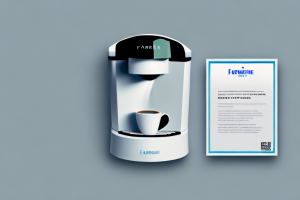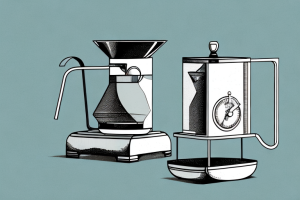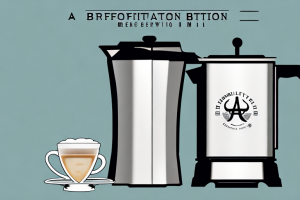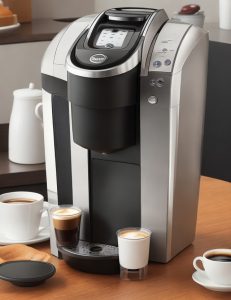Clean Coffee Maker With Baking Soda

A coffee maker with a box of baking soda beside it
There’s nothing quite like the aroma of freshly brewed coffee to start your day. However, if your coffee maker isn’t clean, that delicious scent can quickly turn into a sour one. That’s why cleaning your coffee maker is crucial not only for maintaining its longevity, but also for ensuring that the coffee you drink is safe and free from harmful bacteria and germs. In this article, we’ll explore why cleaning your coffee maker is essential, the benefits of using baking soda for cleaning, and provide a step-by-step guide to cleaning your coffee maker with baking soda.
Why Cleaning Your Coffee Maker is Important
Over time, your coffee maker can accumulate mineral deposits, coffee oils, and bacteria that can affect the taste and quality of your coffee. Not only that, but a dirty coffee maker can become a breeding ground for harmful bacteria, putting your health at risk. If you’re someone who drinks coffee regularly, it’s essential to clean your coffee maker to avoid any harmful buildup that can occur and to ensure that you get the best-tasting coffee from it.
Regular cleaning of your coffee maker can also extend its lifespan. Mineral buildup can clog the machine’s pipes and valves, causing it to work harder and eventually break down. By cleaning your coffee maker regularly, you can prevent this from happening and save money in the long run by avoiding costly repairs or having to replace the machine altogether.
The Benefits of Using Baking Soda for Cleaning
Baking soda is a natural, non-toxic cleaning agent that is effective at removing stubborn stains, grease, and grime. It is also inexpensive and readily available, making it an excellent choice for cleaning your coffee maker. Baking soda is also gentle on the surfaces of your coffee maker, making it a safe option that won’t damage or scratch it.
In addition to being a great cleaning agent for your coffee maker, baking soda has many other uses around the house. It can be used to freshen up carpets, deodorize your refrigerator, and even remove tough stains from clothing. Baking soda is also a popular ingredient in DIY cleaning solutions, as it can be combined with other natural ingredients like vinegar and lemon juice to create effective and eco-friendly cleaning products.
Step-by-Step Guide to Cleaning Your Coffee Maker with Baking Soda
Before starting the cleaning process, ensure that your coffee maker is unplugged and cooled down. Here’s how you can clean your coffee maker with baking soda:
- Fill the water reservoir with a mixture of one cup of warm water and one tablespoon of baking soda.
- Start a brewing cycle without adding any coffee to the filter basket.
- Once the brewing cycle is complete, pour the solution out and rinse the water reservoir with fresh water.
- Fill the water reservoir with fresh water and run another brewing cycle without any coffee.
- Repeat the process until there is no more baking soda residue left in the coffee maker.
- Finally, wipe the exterior surfaces of the coffee maker with a damp cloth.
It is important to clean your coffee maker regularly to ensure that it continues to function properly and produce great-tasting coffee. Neglecting to clean your coffee maker can lead to the buildup of mineral deposits and bacteria, which can affect the taste of your coffee and even make you sick.
Baking soda is a great natural cleaning agent that can effectively remove stains and buildup from your coffee maker. It is also safe to use and won’t leave any harmful residue behind.
How Often Should You Clean Your Coffee Maker?
It’s recommended to clean your coffee maker at least once a month, depending on how often you use it. However, if you’re someone who uses your coffee maker multiple times a day or has hard water, you may need to clean it more frequently. Keeping your coffee maker clean will help maintain its longevity and ensure that you’re getting the best-tasting coffee from it.
When it comes to cleaning your coffee maker, there are a few different methods you can use. One popular method is to mix equal parts water and vinegar and run it through the coffee maker. Be sure to run a few cycles of just water afterwards to remove any vinegar residue. Another option is to use a coffee maker cleaning solution, which can be found at most grocery or home goods stores.
In addition to cleaning your coffee maker, it’s also important to regularly replace the water filter if your machine has one. This will help remove any impurities in the water and improve the taste of your coffee. Most manufacturers recommend replacing the filter every 2-3 months, but this can vary depending on usage and water quality.
Tips for Maintaining a Clean Coffee Maker
There are several things you can do to keep your coffee maker clean and in good working condition:
- Always use filtered water in your coffee maker to prevent mineral deposits from building up.
- Empty the carafe and filter basket after every use to prevent coffee stains and residue from accumulating.
- Wash the carafe and filter basket after every use to keep them clean.
- Regularly descale your coffee maker to remove mineral buildup.
In addition to the above tips, here are two more ways to maintain a clean coffee maker:
- Use a mixture of vinegar and water to clean your coffee maker. Fill the water reservoir with equal parts vinegar and water, and run the coffee maker through a brewing cycle. Then, run it through another cycle with just water to rinse out any remaining vinegar. This will help remove any stubborn stains or buildup.
- Replace your coffee maker’s water filter regularly. Most coffee makers come with a water filter that needs to be replaced every few months. This will help ensure that your coffee tastes fresh and prevent mineral buildup in your machine.
Alternatives to Baking Soda for Cleaning Your Coffee Maker
While baking soda is an effective option for cleaning your coffee maker, there are other alternatives you can use if you don’t have baking soda on hand:
- Vinegar – a mixture of equal parts water and white vinegar can be used to clean your coffee maker.
- Lemon juice – a mixture of lemon juice and water can be used to remove stains and mineral buildup.
- Dish soap – a few drops of dish soap and warm water can be used to clean your coffee maker.
It’s important to note that while these alternatives can be effective, they may not work as well as baking soda for certain types of buildup or stains. Additionally, it’s important to thoroughly rinse your coffee maker after using any of these cleaning methods to avoid any residual taste or odor.
Common Mistakes to Avoid When Cleaning Your Coffee Maker
When cleaning your coffee maker, there are a few common mistakes to avoid:
- Not emptying the carafe and filter basket after every use – this can lead to coffee stains and residue buildup.
- Using too much baking soda – using too much baking soda can leave a residue and affect the taste of your coffee.
- Not rinsing the coffee maker thoroughly – if you don’t rinse your coffee maker properly, you may end up with a soapy or off-tasting coffee.
Another common mistake to avoid when cleaning your coffee maker is not descaling it regularly. Over time, mineral deposits from the water can build up in your coffee maker, affecting the taste of your coffee and even causing damage to the machine. To descale your coffee maker, mix equal parts water and white vinegar and run it through the machine. Then, run plain water through the machine a few times to rinse it out.
It’s also important to clean the exterior of your coffee maker regularly. Wipe down the outside of the machine with a damp cloth to remove any dust or grime that may have accumulated. This will not only keep your coffee maker looking clean and shiny, but it will also prevent any dirt or debris from getting into your coffee.
How to Deep Clean Your Coffee Maker with Baking Soda
If your coffee maker has significant stains and buildup that baking soda alone can’t remove, you may need to deep clean it using a stronger solution. Here’s how:
- Mix a quarter of a cup of baking soda with a quarter of a cup of vinegar in the water reservoir.
- Run a brewing cycle without any coffee.
- Once the brewing cycle is complete, let the solution sit in the carafe and reservoir for a few hours.
- Rinse the coffee maker thoroughly with fresh water and run a few brewing cycles with just water.
Removing Tough Stains and Buildups from Your Coffee Maker
If you have stubborn stains or mineral buildup in your coffee maker, you can use baking soda and vinegar to remove them:
- Mix equal parts baking soda and vinegar to form a paste.
- Apply the paste to the stained areas and let it sit for a few hours.
- Scrub the stained areas with a soft brush or sponge.
- Rinse the coffee maker thoroughly with fresh water.
How to Clean Different Types of Coffee Makers with Baking Soda
Baking soda is a versatile cleaner that can be used on different types of coffee makers:
- Drip coffee maker – follow the step-by-step guide provided earlier in this article.
- Single-serve coffee maker – fill the water reservoir with a mixture of one cup of warm water and one tablespoon of baking soda. Run a brewing cycle without the coffee pod and repeat the process with fresh water until there is no baking soda residue left.
- French press – add warm water and baking soda to the French press and let it sit for a few hours. Scrub the press with a soft brush or sponge and rinse thoroughly with fresh water.
- Espresso maker – dissolve one tablespoon of baking soda in one cup of warm water and pour the solution into the water reservoir. Run a brewing cycle without coffee, and repeat the process with fresh water until there is no baking soda residue left.
The Importance of Regular Maintenance for a Longer-Lasting Coffee Maker
Regular maintenance is crucial for keeping your coffee maker in good working condition and extending its lifespan. By cleaning your coffee maker regularly and following the tips provided in this article, you can ensure that your coffee maker delivers delicious, hot coffee every time you use it.
Eco-Friendly and Budget-Friendly Ways to Clean Your Coffee Maker
Baking soda is a natural, eco-friendly, and budget-friendly cleaning agent that you can use to clean your coffee maker. By using baking soda instead of harsh chemicals, you’re doing your part in protecting the environment while saving money.
DIY Cleaning Solutions for a Sparkling Clean Coffee Maker
If you prefer using natural cleaning solutions, here are some DIY cleaning solutions you can use to clean your coffee maker:
- Baking soda and vinegar – mix equal parts baking soda and vinegar to form a paste and use it to clean and polish your coffee maker.
- Lemon juice – a mixture of lemon juice and water can be used to clean and remove stains from your coffee maker.
- Essential oils – add a few drops of essential oils like lavender or tea tree oil to a mixture of water and baking soda to create a fragrant, natural cleaning solution.
By following these tips and using baking soda or other natural cleaning agents, you can keep your coffee maker clean, safe, and in top working condition. So the next time you brew your coffee, you can enjoy a fresh, delicious cup of coffee without any unpleasant aftertaste.



